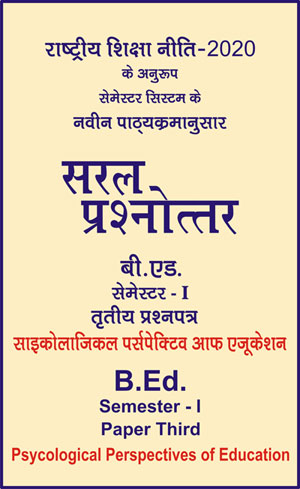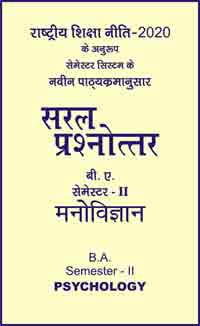|
बी एड - एम एड >> बी.एड. सेमेस्टर-1 प्रश्नपत्र-III - साइकोलाजिकल पर्सपेक्टिव आफ एजूकेशन बी.एड. सेमेस्टर-1 प्रश्नपत्र-III - साइकोलाजिकल पर्सपेक्टिव आफ एजूकेशनसरल प्रश्नोत्तर समूह
|
5 पाठक हैं |
|||||||
बी.एड. सेमेस्टर-1 प्रश्नपत्र-III - साइकोलाजिकल पर्सपेक्टिव आफ एजूकेशन (अंग्रेजी भाषा में)
Question- State the Thorndike’s Law of learning.
Answer-
Thorndike’s Law of Learning - Thorndike, three main rules of learning and five secondary rules have been propounded. Which are described below :
Primary Law
The main rules are briefly described as follows :
(1) Law of Readiness : Under this rule, if the child is ready to learn any task, then he learns it soon, because in readiness lies the willingness to act. Due to readiness, the child learns any subject efficiently. Readiness helps him to focus his attention on the task, as a result of this, he becomes successful in doing it.
(2) Law of Use or Exercise : This rule has the following two parts:
(A) Rules for the use of Exercise : The meaning of this rule is that practice makes skillful. If we keep practicing a task, we learn it successfully and become proficient in it. For example : we cannot achieve proficiency in riding a bicycle or a motorcycle without practicing.
(B) Application Rules of Practice : The meaning of this rule is that if we do not practice what we have learned, we gradually forget it. So it is very important to practice to remember it.
(3) Law of Effect or Satisfaction : According to this rule, we want to learn that work which effect is beneficial for us and again we can get happiness and satisfaction. On the contrary, we don’t do that work neither do we learn, by doing and by learning which we suffer.
Secondary Law
A brief description of this is, given as follows :
(1) Law of Multiple Response : According to this law, when we do or learn any new task, we react to it in many different ways. In other words, we can say that to achieve success in any work, we use different types of measures and methods. After tracking for sometime, we get to know the right method or way to achieve success in that task.
(2) Law of Disposition : According to this law, we learn from him in proportion to the attitude we have towards him. If we are not mentally ready to do any work then we will not get success in work or we can do many mistakes or we are ready to learn or do then we can do that work in a best form.
(3) Law of Partial Activity : According to this law, we divide the work we want to do into small parts. This type of division, makes the task simple and convenient because we can easily complete the work by shielding the small parts.
(4) Law of Assimilation : According to this law, whatever new knowledge we acquire its assimilate it that in other words, it can be said that we make new knowledge a temporary part of our previous knowledge because when the teacher imparts any new knowledge to the child, it establishes a relation with what has already been learned.
(5) Law of Associative Shifting : According to this law, to do the action that was done earlier in the same way in another situation, the circumstances change in it, but the nature of the action remains the same.
Other Important Laws of Learning
Apart from the above given rules, other important rules of learning are as under :
(1) Law of Purpose : According to this law, we quickly learn the work that complete us.
(2) Law of Recency : According to this law, the closer a task has been learned in the past or less time, the more successfully it can be done again.
(3) Law of Maturation : According to this law, we can learn a task only when we have the physical or mental maturity to learn that work.
(4) Law of Distribution of Practice : According to this law, one should learn after sometime and after sometime by continuously doing a task.
(5) Law of Multiple Learning : According to this law, the child learns the things that come in his lesson in school. All the same time one learns many things from the character of the teacher, from the company of the student and also from the environment.
|
|||||














